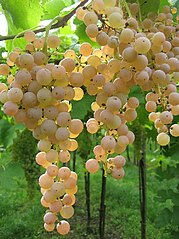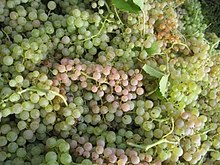Garganega
| Garganega | |
|---|---|
| Synonyms | Grecanico, Oro - for more see the Synonyms section |

|
|
| Art | Grape vine ( Vitis vinifera subsp. Vinifera ) |
| Berry color | yellow-green |
| use | |
| origin | Italy |
| VIVC no. | 4419 |
| List of grape varieties | |
Garganega is a white wine variety that is particularly widespread in the Italian region of Veneto . The vine is also commonly found in the Italian regions of Lombardy and Umbria .
Origin, descent
The variety probably comes from the province of Verona in Veneto.
The very old grape variety was mentioned as early as the 13th century by Petrus de Crescentiis (1230-1320). As with some other Italian grape varieties such as Greco, a Greek origin is suspected, which would also be confirmed by the occurrence in Sicily. To date, however, no genetic relationships with Greek varieties have been established.
Garganega is considered the leading variety in the European gene pool, from which many others are derived. It is identical to the Grecanico Dorato (Grecanico) grown in Sicily and to the Malvasía de Manresa, which was previously cultivated in Catalunya, Spain. There are direct parent-offspring relationships with the varieties Albana, Catarratto Bianco, Dorona di Venezia, Malvasia Bianca di Candia, Marzemina Bianca, Montonico Bianco, Mostosa, Trebbiano Toscano and Susumaniello. Furthermore, there is a genetic proximity to the varieties Corvina Veronese , Dindarella , Oseleta and Rondinella . The variety was also a cross partner in the new breeds Fedit 51 and Pirovano 91.
The varieties Garganega and Grecanico Dorato (is the name of the variety in Sicily) are identical (see synonyms).
Ampelographic varietal characteristics
- The tip of the shoot is hairy with white wool with a very slightly reddish tinge. The green, slightly white-colored young leaves are slightly woolly hairy.
- The medium-sized leaves are usually five-lobed and strongly curved. The stalk bay is closed like a lyre. The leaf margin is bluntly serrated. The teeth are set medium-wide in comparison to the grape varieties. The leaf surface (also called blade) is blistered and rough.
- The cylindrical grape is large, 20-25 cm long and has loose berries. The round berries are medium-sized and pink to whitish in color. The berry is juicy and has a slightly perfumed taste; the juice is colorless.
Maturity: Garganega ripens approx. 30 days after the Gutedel and is one of the late-ripening varieties.
distribution
The world acreage in 2010 is 15,402 ha and is cultivated in Italy, Argentina and Brazil. In 1990 it was 16,549 ha.
With about 13,050 hectares (1998) of cultivation area, it is an important Italian white wine grape and main component of important white wines , for example Colli Berici , Colli Euganei , Gambellara or Soave .
Wine
The late-ripening variety is very productive and produces fragrant wines with a pleasant, if only light, almond and lemon aroma (→ aromas in wine ). With rigorous yield restrictions, dense, full-bodied wines can be produced. If the yield is high, the wine becomes quite thin and has only a neutral taste.
When dry, the berries can be processed into Vino Santo or Recioto di Soave . The variety is also popular locally as a table grape .
properties
Garganega has good resistance to fungal diseases. The yields are regular and high.
Synonyms
Bianchetto, D'Oro, Decanico, Dorana di Venetia, Garganega Bianca, Garganega Bijela, Garganega Comune, Garganega, Gambellara, Garganega Gentile, Garganega Grossa, Garganega Piramidale, Garganega Veronese, Garganego, Garganegra, Gargania, Garganica, Gracanico, Dorato, Grecani Grecanico, Grecanico Bianco, Grecanico Dorato, Grecanicu Biancu, Grecanio, Greccanico, Greco d'Arcetri, Lizzara, Malvasia Bianca di Basilicata, Malvasia de Manresa, Ora, Ora d'Oro, Oro, Ostesa, Ostesona, Recanico, Recanicu, Weisser Terlaner .
Despite morphological similarities, it must not be confused with the varieties Dorona di Venezia, Ribolla Gialla or Vitovska.
literature
- Pierre Galet : Dictionnaire encyclopédique des cépages. Hachette, Paris 2000, ISBN 2-01-236331-8 .
- Jancis Robinson : The Oxford Wine Lexicon. 3rd, completely revised edition. Hallwag, Munich 2007, ISBN 978-3-8338-0691-9 .
Individual evidence
- ^ Jancis Robinson , Julia Harding, José Vouillamoz : Wine Grapes. 1st edition. 2012, Penguin Books, London, ISBN 978-0-06-220636-7 .
- ↑ K. Anderson, NR Aryal: Database of Regional, National and Global Winegrape Bearing Areas by Variety, 2000 and 2010, Wine Economics Research Center, University of Adelaide, December 2013 (first revision April 2014) (second revision May 2014) (third revision July 2014).
- ↑ Garganega in the database Vitis International Variety Catalog of the Institute for Vine Breeding Geilweilerhof (English), April 2020.



